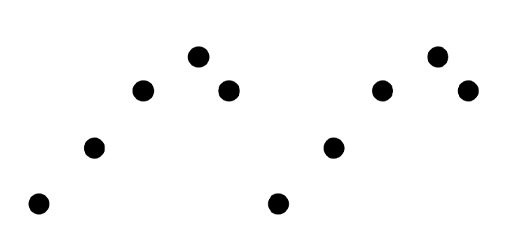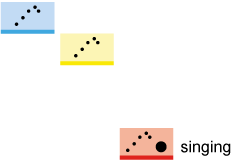1.4 Harmonic progressions: the 12-bar blues structure
Over time, convention has dictated familiar patterns in harmonic progressions (a series of chords) in musical genres worldwide. In Western blues and popular music, a commonly used harmonic progression is the 12-bar blues. If you have listened to popular music there is a strong probability that you have heard this harmonic progression before.
You will explore use of the 12-bar blues in the opening of Good Golly Miss Molly by Little Richard. Rather than focusing on the melody, when undertaking the listening activities in this section you should focus on the instrumental accompaniments. In Good Golly Miss Molly this is played by the rhythm guitar, bass guitar and drums (ignore what the piano is playing). The notes of the guitars are easiest to pick out, and these form the bass line, playing the important harmony notes. You will notice that the guitars play a repeated pattern of five notes (see Figure 3) which is often played twice (Figure 4) before the pattern sounds again at a higher, lower or at the same pitch. What you are hearing when you listen to this part of the instrumental accompaniment is the harmonic progression.
Activity 5
This activity is in two parts and involves listening to the opening of Good Golly Miss Molly in Audio 29.
To begin, you will concentrate on the harmonic progression which occurs before the melody begins at c.00:16, identified by the word ‘singing’ in Figure 5. There are seven broader shifts in the harmonic progression (represented by coloured boxes in Figure 5) and these sound at a higher, lower or at the same pitch (indicated by the colours of red, yellow and blue). If you count the number of times the guitar pattern shown in Figure 3 is visible in the first seven coloured boxes of Figure 5, you will notice that there are eleven repetitions.

For the first part of this activity listen to the instrumental opening which you can hear prior to c.00:16 in Audio 29. Listen for the guitar pattern represented in Figure 3, and the broader shifts of the harmonic progression represented in the first seven coloured boxes of Figure 5. You may find that you need to listen to the extract more than once.
After you have done this and can hear the harmonic progression before c.00:16 think about what happens to the instrumental accompaniment after this point in the audio, once the singing has begun. Does this change or does the instrumental accompaniment follow a familiar pattern? This is only partly represented in Figure 5, but it will give you an idea of what you can expect to hear.
Discussion
You may have noticed that after the singing begins, a broader pattern is starting to form (this is visible in Figure 5 in the five coloured boxes after the word ‘singing’).
You may have also noticed while listening to Audio 29 and looking at Figure 5 that the lowest pitch (the red coloured box) is predominant, and this represents the feeling of ‘home’ mentioned described in the previous section. These features are represented in Figure 6.
The ‘home’ chord (represented by the red box) is well established, before the music moves away, and then returns to give a feeling of completeness (as shown in Figure 7).
If you continue to follow the harmonic progression beyond the first four coloured boxes, you will notice that prior to the word ‘singing’ there are only three remaining coloured boxes (shown in Figure 8). This part of the harmonic progression does not start at ‘home’ but finishes there. Comparing Figure 7 and Figure 8, you will notice that the three coloured boxes of Figure 8 form an uneven grouping of chords (three chords rather than the four chords represented in Figure 7). This is due to the dramatic break in the harmony which is marked by silence before the singing begins, and is represented by a dot in Figure 8. It is at after this point that the broader harmonic progression begins to repeat, and so this represents an important moment in the music.
If we count the dot as an additional (silent) sounding of the guitar pattern shown in Figure 3, the total number of repeats of adds up to twelve (represented in Figure 9). This is where the 12-bar blues form gets its name.
Activity 6
Now listen to Let’s Stick Together by Bryan Ferry. Here the accompaniment is played by saxophones, rhythm guitar, bass guitar and drums. Try to follow the overall shape of the harmonic progression represented by the coloured boxes in Figure 9 and listen out for any similarities or differences in comparison to Good Golly Miss Molly.
Discussion
The overall shape of the harmonic pattern was the same but there are some minor differences in the musical detail. Firstly, the bass guitar played varied patterns of notes across the ‘12-bars’ and was not as consistently repetitive as we heard in Good Golly Miss Molly. The rhythm guitar accompanied the bass guitar with strummed chords rather than individual notes. Secondly, the end of the harmonic progression was marked by repeated chords in the rhythm guitar, bass guitar and drums rather than silence. However, aside from these small details, the harmonic progression was identical which may come as a surprise, since the musical styles were very different.






